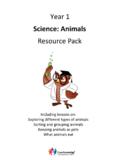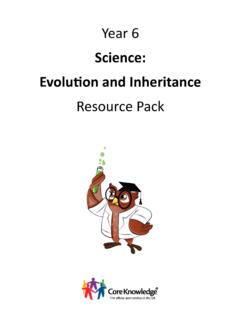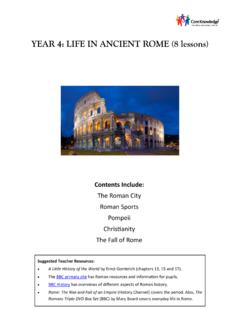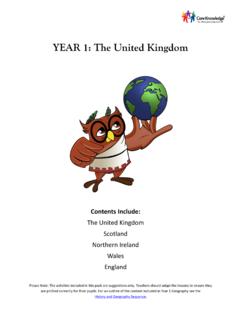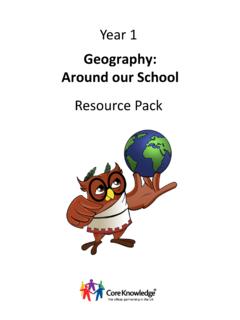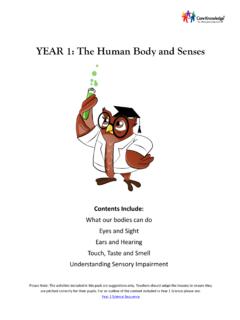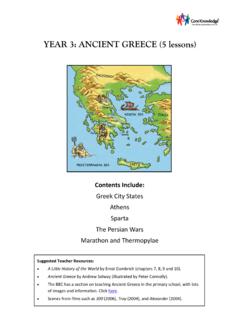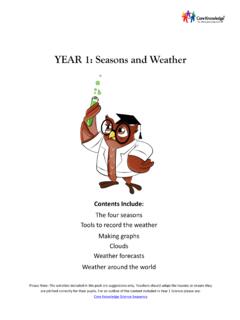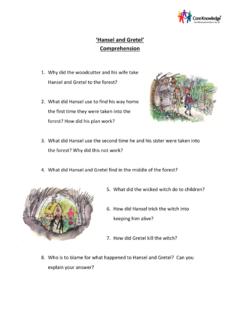Transcription of Year 1 Science: Growing Plants Resource Pack
1 year 1 Science: Growing Plants Resource pack Including lessons on: What Plants need to growNaming and describing parts of plantsDeciduous and Evergreen Plants we eatFarming and foodScience Unit Overview year One Plants and Plant Growth Growing Plants Plants need light, water, soil andwarmth to grow. Plants use light to make their ownfood. Plants have seeds, roots, stems of Plants Plants spread their seeds in differentways in order to reproduce. Some Plants drop their leaves everyyear; they are called deciduous. Some Plants keep their leaves all year ;they are called and Farming We eat some types of Plants . Forexample: root carrots, stem-celery, leaves-lettuce, seeds peas We eat food grown on farms or inorchards.
2 Some food we eat comes fromother countries BananasGrowing Plants Grow cress seeds on cotton wool andkeep a cress diary Investigate: Grow a bean in a seethrough pot ( 246) Investigate: what happens when seedsare left in the dark or without water ( ) Investigate: Put a white carnation inwater with food colouring to show howwater is taken into the of Plants Look at examples of deciduous and evergreentrees, compare their leaves. Discuss why trees may drop their leaves, whysome Plants grow in the spring etc. Investigate: Look at leaves under amicroscope or with a good magnifying can we see? Why can t we see the samewith our bare eyes?
3 Food and Farming Cut up vegetables and discuss whichparts are eaten the root or stemor leaves. Follow the journey of a bananaVisit a farm or city farm and seevegetables or fruit Knowledge Creative application of knowledgeLesson 1: What Plants Need This lesson is the first lesson in a series that introduces children in year 1 to the world of Plants . Children will understand that Plants need warmth, light and water in order to grow. They will look at the ideal conditions for Plants and will grow their own Plants from seeds. Children will begin to understand that when Plants do not receive adequate warmth, light and heat, they may not grow properly.
4 Some children may begin to understand that some Plants have adapted to grow in harsh conditions, such as in the desert or in the arctic. This lesson can be brought to life by children Growing some Plants in the classroom or in an outside space in the school. Fast Growing Plants such as cress are useful for children to observe seed germination and plant growth. Sunflowers grow rapidly in the right conditions and children can monitor their growth over time. See pages 247 and 248 of What your year 1 Child Needs to Know Learning Objective Core Knowledge Activities for Learning Related Vocabulary Assessment Questions To know what Plants need in order to grow.
5 Plants need warmth,light and water to grow Plants grow from seeds If seeds do not havewarmth, light and water,they may not grow intohealthy Plants Investigate what Plants need to growby putting cress seeds in differentconditions. For example, some seedson a damp paper towel in thewindow, and some in a darkcupboard. Ask the children to checkeach day and look at what haschanged. Children could alsoinvestigate water by putting someseeds in a small pot of water, some ondamp paper towel and some with nowater at all. Children can record theirobservations. Children could be responsible forlooking after some small pottedplants- or a garden area if warmth light grow water germinate seeds healthy What do Plants need in order to grow?
6 Describe what would happen to a seed placed in a dark area. Explain why watering a plant is important. Describe the best way to grow a healthy plant. Resources: This BBC Online Activity allows you to water a plant and watch it grow. This Gardening Guru activity from the BBC is also a useful interactive Resource for children. The Royal Horticultural Society has some good gardening lesson plans. My Cress Diary By: First Observation _____Second Observation _____Third Observation _____ Lesson 2: Parts of Plants In this lesson, children explore the basic parts of a plant including the roots, stem, leaves and flowers.
7 By the end of the lesson, children should be able to explain the purpose of each part of the plant. Children will learn that in most Plants , the roots act as an anchor, holding the plant in the ground. Roots also absorb water and essential minerals from the soil. Nutrients and water are carried around the plant via the stem which also holds the leaves up above the ground in the sunlight. Plants require sunlight for photosynthesis, the process by which Plants convert energy from the sun into chemical energy which is used for growth. It is important for leaves to access sunlight in order for photosynthesis to occur.
8 The flower has a vital role in reproduction. See pages 242 and 243of What your year 1 Child Needs to Know Learning Objective Core Knowledge Activities for Learning Related Vocabulary Assessment Questions To name and describe the purpose of parts of a plant. Roots- the roots of a plant act as an anchor, fixing the plant into the ground. They also absorb water and minerals to help the plant to grow. Stem- the stem of a plant grows above the ground. The leaves and flowers grow from it. The stem is also used to transport water and minerals around the plant. Leaves- a plant s leaves absorb sunlight and turn it into energy that the plant uses to grow.
9 Flower- the flower is the part of the plant where seeds are made. Show children a small pot plant- carefully remove the plant from the pot, gently brushing of the soil from around the roots. Children will be able to see the roots, leaves, stem and flower. Explain why each of these is very important. Demonstrate how Plants absorb water through the stem by putting some white carnations in water with food colouring. In around 24 hours children will be able to see the flower coloured by the ink. Grow a bean plant (see Resource links) Visit a park or garden and look at some of the Plants Growing there. Identify the purpose of each part.
10 Roots anchor absorb minerals stem leaves flower energy transport Also include common names of wild and garden Plants . Can you describe a plant? Why does a plant need roots? How does a plant get energy to grow? Where do Plants make their seeds? Resources: This BBC clip explains why Plants need their roots. How to grow a bean- easy to follow instructions. LO: To name and describe parts of a plant. Name: Date: leaves The roots _____ _____ The stem _____ _____ The leaves_____ _____ The flower_____ _____ Describe what each part does: stem roots flower Lesson 3: Seeds In this lesson, children will learn that Plants spread their seeds in order to reproduce.
